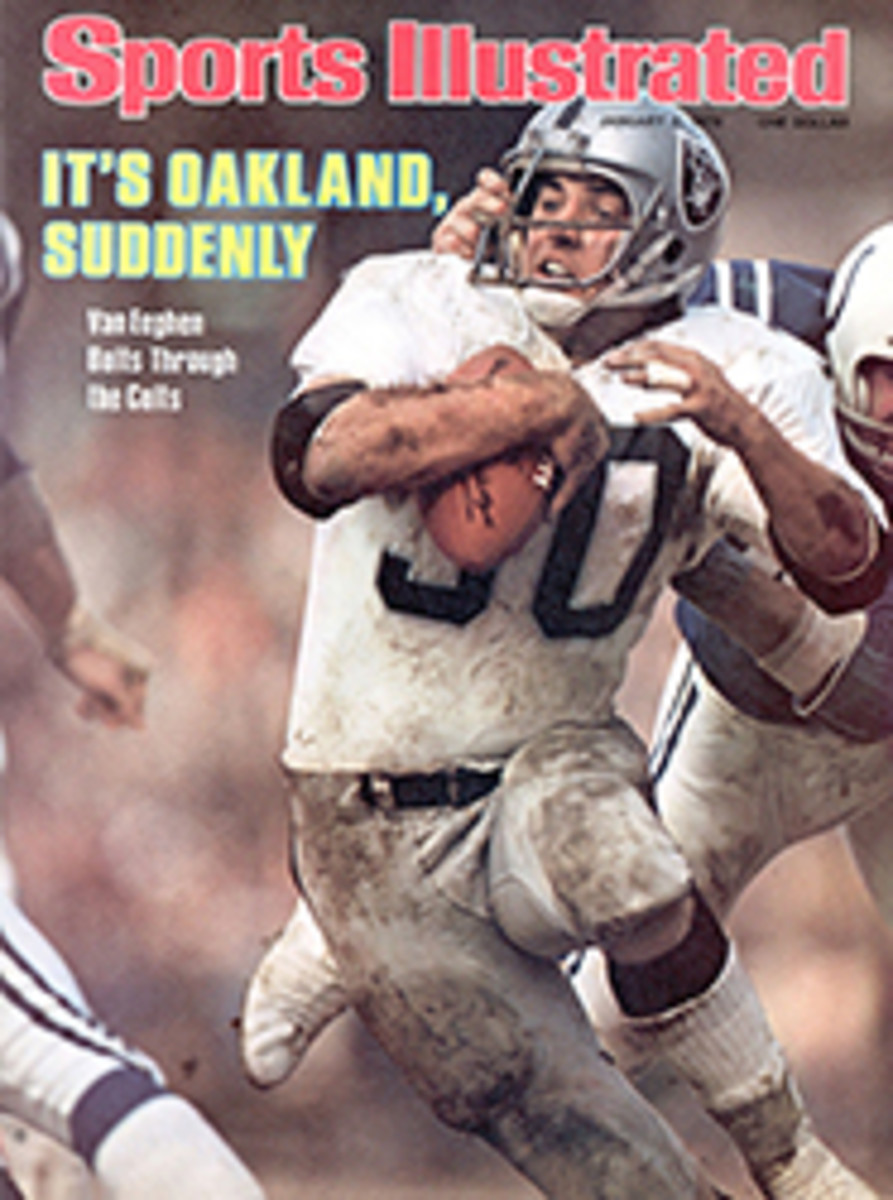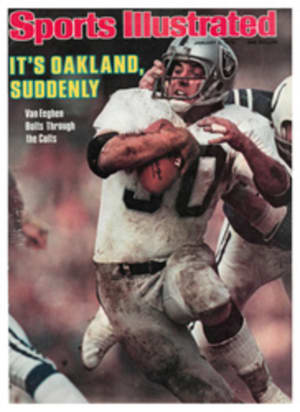
Jungle Jim and the rocky run
Ever since the first side-by-side slalom was staged by the World Pro Skiing circuit eight years ago, the idea of an all-professional downhill race has lingered in the air like a snowflake looking for the right spot to land. The notion was not brand new—the world's first pro race in 1961 was a modified downhill—but it continued to intrigue the band of amateur retreads who make a fancy living by skiing for money. The start of the new season at Aspen on Dec. 15 seemed as good a time as any to try a downhill and, lo, the event was received like an idea whose time had come. Perhaps it was because the setting was right: a fast and rich new contest in a fast and rich town.
To be sure, the downhill was richer than it was fast, but it was a success anyhow. The purse for the three-day competition—downhill, giant slalom and slalom—was $80,000, which made it the richest ski event ever. The downhill made it interesting as well as historic.
Because most of the pros hadn't raced downhill for years, the course on Buttermilk Mountain was deliberately made easy—a piece of cake by World Cup standards. The run was relatively short, 6,000 feet, and relatively flat, with a vertical drop of 1,200 feet, and the only thing that brought the racing speeds up to 60 mph was that the course was what Olympic downhiller Franz Klammer might call a relative straightaway. The most dangerous part of the hill was at the stopping area beyond the finish line. There wasn't very much of it, and more than one racer stopped by plopping over a five-foot embankment into the gallery.
But the simplicity of the setup was ideal for pros. Eighty racers turned out for qualifications, about a third more than show up for most of the circuit's slalom races, even though they hadn't had much specific notice. Last September, World Pro Skiing had sent a letter to its racers that said, in effect: Be prepared for a downhill next year. We're not sure where or when, just be ready. The WPS had at least one good reason for being so noncommittal: after last year's disastrous dry winter, it was reluctant to schedule a downhill only to be forced to cancel it for lack of snow. No use blowing the stage-setting race. But a snowstorm hit the Rockies on Dec. 2, dropping a foot of snow on Aspen, and the pros decided to make a run for it.
There will be four or five more downhills this season, snow permitting, and the courses will likely not be much different. Things don't work the same way in the U.S. as they do in Europe, because the American audience is a different breed. Technically tricky runs are less important than simply putting on a good show. So the pro downhills will be shorter, enabling spectators to see more of the race, and they will be situated so that the crowds can watch more of the good stuff from the bottom of the hill. Having ruled out dual-course, side-by-side downhill racing as too dangerous, the WPS devised a new format to make the event more exciting. Qualifying produces a starting lineup of 32 racers. One run cuts that field in half, and the 16 survivors go back up the hill for a second run. But unlike normal downhills, the racer with the slowest time for the first run now starts first, and the fastest man starts last. It makes for a handicap system of sorts, because ski-racing courses become more rutted and slower with each run. Fastest combined time for the two runs wins. The format would seem to make sense, because the pro circuit has been surviving by stressing entertainment as much as competition, with its pro racers a cut below World Cup skiers in terms of speed and skill. The harshest critics say the pros are all has-beens. "If it weren't for the pro circuit, they would all be off mounting bindings someplace," says one. One who most certainly wasn't a has-been was Henri Duvillard of France, who so dominated the pros for the past two years that his skis are now exhibited in a ski museum in Vail. But Duvillard retired after last season, and the role of hero has been assumed by Josef Odermatt, a Swiss who was runner-up to (and psyched out by) Duvillard the last two years.
Odermatt won both the slalom and GS on Buttermilk, but finished sixth in the downhill. He was not dismayed: he was never a world-beater in downhill (when on the Swiss national team he raced in seven World Cup downhills and never finished in the top 10). Odermatt doesn't particularly care for the event, hadn't trained for downhill this year—which made him no different from the vast majority of the racers—and even arrived in Aspen with no downhill skis. Before the race, Odermatt had been rather negative about the whole affair, allowing that, "If I don't do well in downhill here, I'm not going to race in the other downhills this year because it's not worth taking the chance to get hurt. I was coming to the pros with slalom and GS as my specialty. My strongest thing has always been to race against another guy. I like to have a competitor I can fight with, then I do really better. I'm maybe not so good against the clock. Anyway, downhill is a lot of hassle. This course is not that easy, it's really rough. There's not enough snow, and every run turns up a couple more rocks. You start to make a turn and your tail kicks up a rock and your skis go straight. It's dangerous."
"It's doubtful if they would permit a World Cup on a course in this condition," said rookie pro and former Canadian national team downhiller Jim Hunter. Hunter's downhill reputation—a third, fifth, two sixths, a seventh and ninth in eight World Cup downhills in 1976, as well as a 10th in the Innsbruck Olympics—made him the Aspen favorite, even though the downhill would be his pro racing debut. He almost blew it in qualifying, however. The event fell on one of those what-is-so-rare-as-a-day-in-Aspen days: bright blue sky; fat white clouds, uncanny in their knack for dodging the sun; and temperatures in the 40s at the finish line. The day was so warm that rocks sprouted on the course like spring flowers. Hunter tried to dodge them instead of crashing right over them, and qualified 13th fastest.
Hunter skied the course in 1:19.779 in his first run and turned up in the lead, but only by .012 seconds over Steve Devin from Winthrop, Wash., another rookie and the 1976 Can-Am Series downhill champion. Just .059 seconds slower was Rudd Pyles, a 28-year-old, six-year pro veteran from Copper Mountain, Colo. and the local sentimental favorite.
And then, under the bright sun, the course got slower and slower. According to the handicap system, Hunter, skiing last, would face the roughest and slowest course conditions.
Just before the final few racers took off, a gray cloud passed over the sun, and the course cooled and slicked up a bit. Pyles held the lead with a combined 2:41.670 as Hunter waited to start at the top of the hill with the suspense mounting. The sun stayed behind the cloud, and Hunter's form was flawless—even in the air over a compression where he barely came out of his tuck. He didn't bother trying to avoid rocks this time. "I just fought them off," he said, and he finished in 1:20.273 for a combined time of 2:40.052 to edge Pyles by 1.618 seconds. Dave Currier, a former U.S. ski team downhiller and another rookie, was third and Devin was fourth.
Hunter bagged $6,750 for winning his first pro race, and the stories about him began to spread around town. They call him Jungle Jim because he can hang by his toes from the tops of doors, an accomplishment he considers an exercise, not a stunt. Hunter grew up on his family's 2,800-acre farm in Saskatchewan. He considers farm work excellent ski training, and he improvises farm-type workouts. Three or four times a week, he says, he takes a spin curled inside the wheel of the farm tractor while his brother drives. Then Hunter crawls out dizzily, crouches into his downhill tuck position and tries to stay that way without teetering over. He believes that this exercise improves his balance.
Hunter also jogs with the local pastor and recites Scripture with him as they run. Before the start of the Aspen downhill, he recited Isaiah 26:3—"Thou shalt keep him in perfect peace..."—and at the press conference after the race he recited Proverb 16:3, "Count your ways unto the Lord and He shall take care of the rest," which may sound swell while jogging, but in truth paraphrases the Proverb 16:3 in the Bible. Still, somebody up there took care of things for Hunter, who says he hopes to use his ski racing as a springboard to the ministry.
After the race, the rocks were forgotten. It was unanimously agreed that the organizers did all they could to sustain the course. And it was generally agreed that the WPS had a winner in pro downhill racing. Especially if Klammer defects to the WPS. The world champion has publicly noted that his last remaining goal is to win the downhill at the FIS World Championship in January. After that he would turn pro instead of waiting for the 1980 Lake Placid Olympics. Klammer did not specifically swear that he would join the U.S. pros, but the success of the Aspen downhill might encourage him. His presence in pro skiing would help the circuit rid itself of its retread-racer image, and could engender new growth and American interest in downhill racing. For money, that is.
PHOTO

